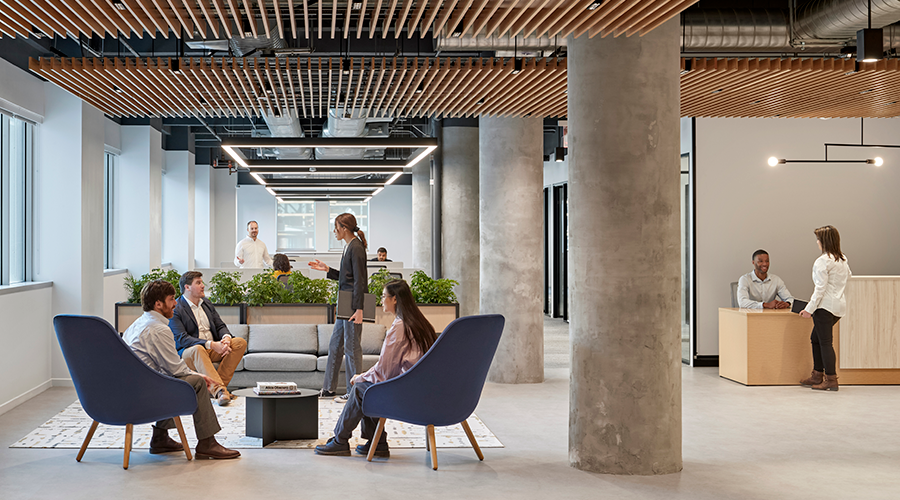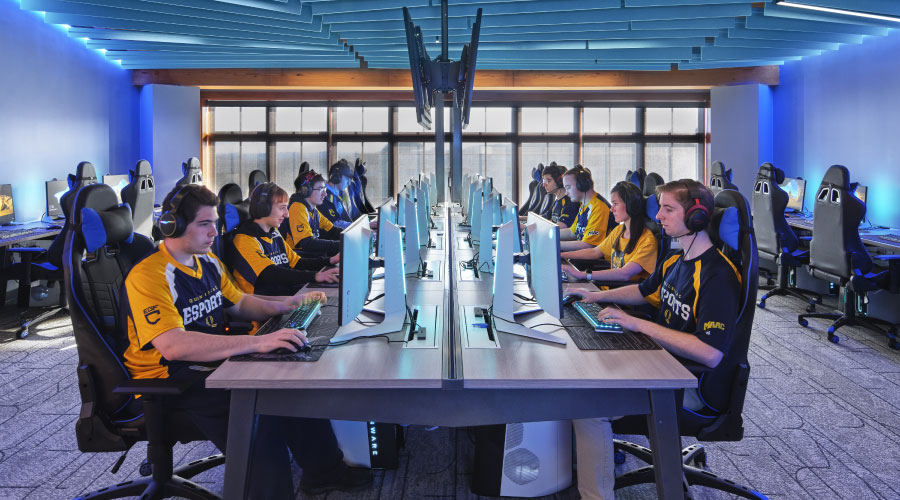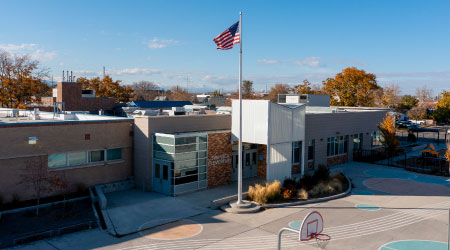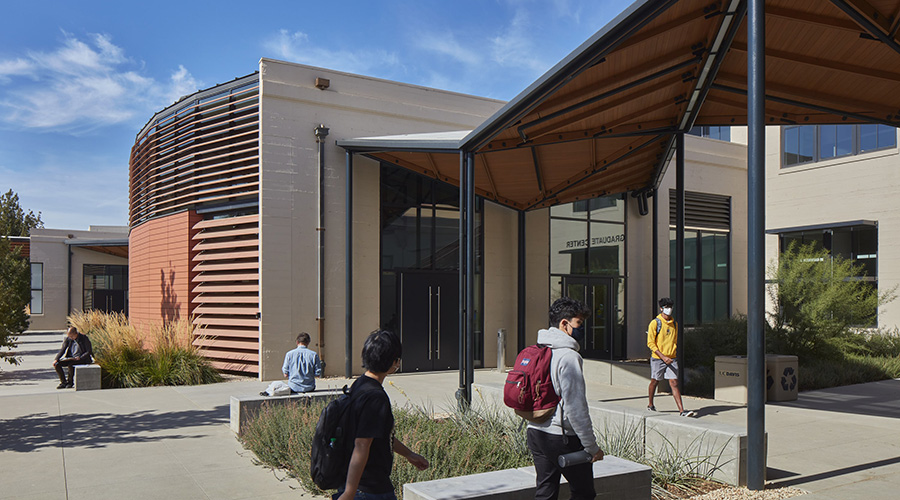School Choice: Build New or Not
Many older schools are in need of upgrades, but determining whether to renovate or build new requires a close look at three critical issues.
Although federal legislation has focused attention on upgrading curricula, teacher qualifications and testing standards, school districts continue to fall behind on modernizing schools. A National Education Association study in 2000 estimated the cost to repair and modernize America’s schools was more than $300 billion. Many school districts are hard-pressed to fund needed upgrades, so they postpone major changes as long as possible. However, rapid changes in technology, new government mandated programs and unsafe conditions are making delay increasingly detrimental.
Three factors generally trigger a decision to take a serious look at an aging school: health and safety deficiencies, outdated or poorly operating building systems, and program changes.
Before a school district embarks on a major renovation project, it must determine whether it is better to replace the existing facility with a new school. Maine mandates such a study before it allocates monies. Some states also are beginning to offer financial incentives for reusing older buildings that are salvageable. While sometimes the cost of replacing outdated systems, upgrading life and safety deficiencies, and accommodating program expansions within existing K-12 schools far exceeds the cost of building a new facility, there may be good reasons for to renovate an older building rather than build a new one.
Question of character
Generally, schools built in the 1950s or earlier have impressive architectural character and often are fixtures in their neighborhoods. They are structurally sound and can accommodate new systems. In addition, there is often strong sentiment to keep them in some form.
Newer schools built in the 1960s and ’70s generally lack architectural character, are not energy-efficient and are constructed of cheaper materials. These get torn down more often or become hand-me-down conversions from high schools to junior highs or from junior highs to elementary schools.
For schools built in the 1980s, the dilemma is not so much whether to replace or renovate but how to add to the structure in an economical and aesthetically pleasing manner.
Another important reason why older buildings are renovated is because there is no new land available to move the school or the available land is prohibitively expensive.
A final factor is whether a renovation can be undertaken while a school is in use. If the goal is to continue to occupy the building, developing a phased construction schedule, which separates construction from occupied areas, is critical.
It is impossible to generalize. Community needs and sentiment, facility deficiencies and economics all play roles. Renovating can simply be the right thing to do, make the most economical sense or provide a school district with the right space given available funds. One thing is certain: Renovating older schools is challenging.
Health and safety upgrades
The news is rife with stories about unsafe and unhealthy schools that are unexpectedly closed because of mold contamination, indoor air quality problems or other unsafe conditions. Safety and health problems leave little room for procrastination. The immediate problem can be diagnosed and fixed, but the situation triggers a serious review of all systems.
A major cause of many indoor air quality problems relates to poorly ventilated spaces. Older schools often were designed without ventilation systems; with the exception of some unit ventilators, open windows served that function. Even the ventilation provided in more recent schools does not always meet codes for outdoor air.
Other health- and safety-related issues that can trigger major upgrades include electrical systems that are inadequate and unsafe, lack of sprinkler systems, asbestos in flooring and pipe insulation, inadequate fire alarm and emergency systems, poorly designed access measures to meet ADA requirements, and inadequate or nonexistent security systems.
Often, the cost of bringing an older school building up to present-day safety, health and access codes can be considerable, adding 10 to 20 percent or more to a budget. Even so, if the basic structure of a building is sound and has not been substantially modified, renovating the building and replacing systems may very well turn out to be the more economical solution.
If updating spaces to accommodate newer or different uses results in significant reconfiguration of walls, however, then the cost may increase dramatically. Again, the type of construction and the materials used will also affect the cost of a renovation. Load-bearing concrete or masonry walls will be more costly to modify than walls of stud construction. Removing load-bearing walls to reconfigure program space may now involve reinforcing the structure, adding columns and beams, and underpinning foundations, which add significant cost.
System upgrades
Most mechanical systems with regular maintenance have an average life of 20 to 30 years. Upgrading them is a prudent but expensive step. However, upgraded systems can provide economic benefits. Today’s mechanical systems come with sophisticated controls, are more dependable and are highly energy-efficient. Individual spaces can be controlled with sensors that can lower temperatures and ventilation rates when a room is unoccupied. The impact of the sun can be modeled and a control system designed to accommodate the increased or decreased amount of solar heat.
Design guidelines such as ASHRAE 90.1 provide energy guidelines that can be used as a minimum benchmark for upgrading or replacing mechanical systems.
Efficient, modular boilers can be used, minimizing stand-by losses. Radiant floor heating systems operate at temperatures between 90 and 115 degrees and not the 180 to 190 degrees required in more traditional systems. In areas where air conditioning is required, today’s cooling systems run on 0.60 to 0.80 kw per ton of cooling, versus older systems that require 1.0 to 2.0 kw per ton of cooling. The energy and operational cost savings in newer HVAC systems can be considerable and result in a 5- to 10-year payback. Some states have established energy guidelines for schools and offer financial incentives to schools using highly efficient systems.
Electrical systems
Electrical systems designed two decades ago are inadequate for today’s technology. Older classrooms often have extension cords and a variety of other cables snaking around the sides of the room and up and down walls to accommodate an abundance of projectors, computers and other teaching technology. Many teaching spaces now include a computer for the teacher, two or more computer workstations for student use, television monitors, videocassette and DVD players, video projectors and enhanced sound systems. All of these devices require more power and more cable. The use of wireless technology does eliminate some of the visible wiring, but it does not completely eliminate the significant increase in the electrical needs of a modern school.
New high-efficiency lamps, multiple lighting levels, direct and indirect lighting, occupancy sensors and light monitoring sensors, and other devices can provide greater control and improved comfort in the classroom. Many older schools still use T-12 fluorescent lamps. In modern schools, it is more common to use the energy-efficient T-8 and T-5 lamps. This change alone in a large school can save considerable amounts in operating costs. For quality of light, the best fixtures are direct/indirect fixtures. These throw light on the ceiling as well as on task surfaces and the illumination is uniform and without glare.
Recent studies have shown that adequate lighting and, in particular, daylight can increase student achievement. Windows in older buildings that were boarded up in the ’70s in the name of energy efficiency took what used to be bright, naturally lit, albeit drafty, classrooms and reduced them to dark caves with no change in the electric lighting. Providing adequate windows that are energy-efficient and help reduce reliance on electric light may improve academics while reducing costs.
Once a building is slated for renovation and the structure is fully evaluated, building envelope issues inevitably arise, such as an inadequate roof structure and leaky windows. Reroofing an older building may require upgrading the structure because of changes in codes. For example, snow loading codes have dramatically tightened.
Older windows usually are single pane and don’t function properly. Schools of the ’60s and ’70s may have used a curtainwall system that is not energy efficient.
Program upgrades
Over the last four decades, state and federally mandated programs, usually unfunded or under-funded, have become a significant challenge for schools. Schools are hard-pressed to find spaces for many of these programs. Closets become meeting rooms; classrooms get divided; hallway dead ends are partitioned.
In addition, changing teaching methods and educational practices require radically different types and sizes of teaching spaces. An example is common spaces where several classes of students can meet at the same time to work together, create large projects or participate in interdisciplinary learning. This modern curriculum will require much greater access to infrastructure, such as power, data, plumbing and mechanical systems, than is available in older buildings. Schools have also become centers of community activities, which require specialized spaces as well.
Aesthetic gains
While aesthetics alone rarely trigger a major renovation, appearance is an added benefit and major focus once design begins. Skeptics may question the viability of turning a tired school into a bright, attractive environment that enhances learning during the abandon-or-renovate analysis. Invariably, the final product will dispel any lingering doubt. Teachers, students and administrators have the opportunity to create environments, in conjunction with the architect and interior designer, that enhance and support their educational philosophy.
Cost and sensitivity to the original design have a lot to do with how a renovation turns out. When it comes to adding on to an older building, it can be relatively easy to match the materials and detailing of the original depending on the style. On much older buildings, this may not be so easy or cost-effective.
Assessments are key
Good school facility executives are generally up to speed on what needs to be upgraded, even before an architect or engineer is hired. They are looking for confirmation as well as the expertise that an architect has to offer. If a school does not have a facility executive or the expertise to know what needs to be upgraded, then the school may look to an architect or engineer to do the evaluation and analysis, and present that information to the school board or building committee. A good analysis should be comprehensive and look at all aspects of a building, documenting the condition of each component, estimating the life expectancy, and determining the cost of replacement or upgrade.
Maine requires every school department or district to do a building assessment on every building and to analyze all of the above items. These assessments must include energy use and maintenance costs. Then these items are compared with new buildings to evaluate how well the building is performing. Schools cannot receive funding from the state’s renovation fund without first doing the assessment. The proposed upgrades need to be prioritized and budgeted. Maine considers life safety issues to be a top priority, building system upgrades as a second priority and new or renovated program space as a third priority.
Surprises and contingencies
With any renovation, there will be surprises. Few schools have copies of original drawings. Even if drawings do exist, past renovations or additions may not be documented. Some schools do renovations and additions themselves, and there is no documentation. Even the best set of documents, however, may not provide every answer.
There will always be hidden elements that no one can predict, such as deteriorating structural elements and mold. Asbestos removal, lead paint and other hazardous building products also must be removed.
Not knowing how a building was constructed, what is above the ceiling or behind the walls, or what the foundation is really like can make it difficult to assess renovation costs. That’s what contingencies are for.
Contingency plans for renovations should include flexible approaches to accommodate surprises. For example, don’t demolish the existing kitchen until the new kitchen is up and running, and keep temporary classrooms on site in the event that classroom space is needed. In addition to the planning to accommodate schedule changes, set aside money for unforeseen conditions. Existing utilities and foundations may not be exactly where expected nor properly dimensioned on old drawings. This often leads to on-site adjustments.
Benefits
There are significant benefits to renovating older schools. The older the school, the more it is viewed with considerable sentiment, particularly if it occupies a prominent location in a community. Keeping these schools enhances a community’s traditions and history. A second benefit is an economic one. New building systems will reduce maintenance and operational costs, as well as provide an environment as good as any found in a new school. A final benefit is related to health and safety. Older schools, not slated for abandonment, need to provide safe and healthy environments for students and teachers.
An older school can be transformed into a vibrant, lively, efficient place of learning. Projects all over the country have proven that.
Jeffrey Larimer, AIA, is an associate, and Clif Greim, PE, is a principal with Harriman Associates in Auburn, Maine.
One school’s choice: Renovation and expansion provide more room on a prime site
A central location and sentiment won out when the town of Scarborough, Maine, addressed solutions to its severely overcrowded high school. Rather than starting with a clean slate, the town chose to expand and renovate the existing facility. Once this decision was made, the challenge for the architect, construction manager and the school administration was how to pull off the multiyear project safely with minimal disruption to teachers and students.
The town never seriously considered a new school on a new site. The existing 135,000-square-foot high school was part of a centralized campus of town facilities that included several schools, town offices, the town library and a winter skating pond. In addition, there was enough sentimental and financial equity in the existing facilities to warrant the upgrade and expansion.
The new 300,000-square-foot school will relieve severe overcrowding that had students eating lunch in the auditorium and taking classes in undersized classrooms, trailers and rooms once used for storage. In addition, many of the core facilities, such as a cafeteria, kitchen and gymnasium, which were undersized and had outdated building systems, will be larger.
|
Build new or not? State steps in to force the analysis
Maine requires schools to analyze renovation and replacement to evaluate whether it is more economical or reasonable to renovate an older school rather than abandon or demolish it.
This analysis must be performed on any new school project that includes abandoning or demolishing an existing school. The cost of renovating an older school to bring it up to code may exceed the cost of building new.
A lot of this is driven by the State Planning Office’s involvement in trying to avoid sprawl by reusing existing schools that are typically located in an established neighborhood setting as opposed to buying undeveloped land that doesn’t have the needed infrastructure, arrangements for bus transportation and other issues established locations offer. Schools from the ‘60s and ‘70s tend to be on larger parcels of land to begin with and are usually easier to renovate or add on to.
|
Related Topics:











